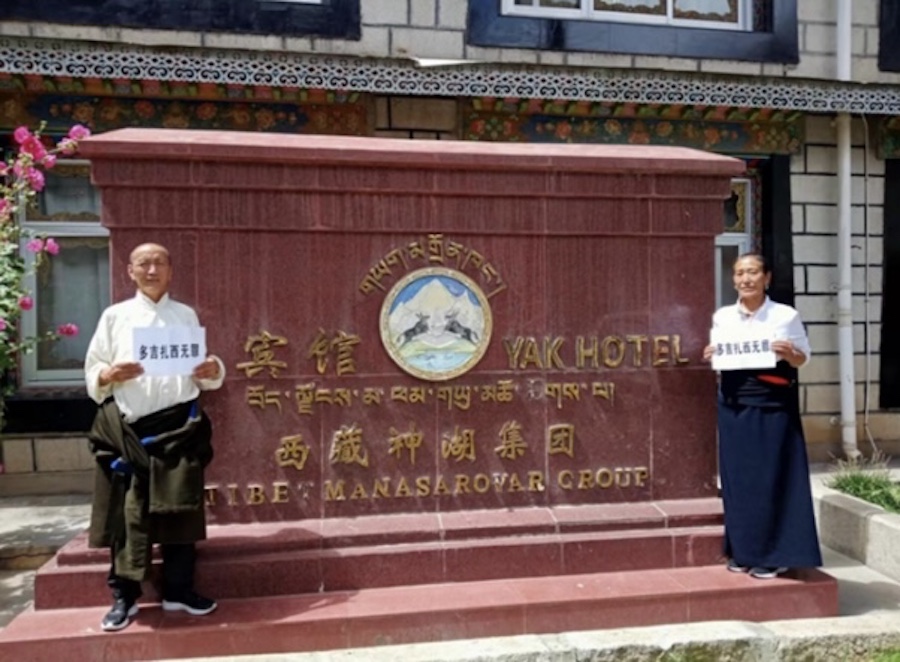The former political prisoner Lobsang Damchoe passed away in Gyantse on 31 January 2003. Lobsang Damchoe, a monk in his late sixties, died after long-term ill health. He had been released from Nyari prison on medical parole in 1999, in the middle of a 5-year sentence for political offences. The life of Lobsang Damchoe is a typical example of a monk who survived the Cultural Revolution and was arrested and sentenced again in the 1990s for renewed involvement in political activities. Unlike some other high profile former prisoners, Lobsang Damchoe was not of high social background in the ‘old’ society, neither was he ever rehabilitated in any significant position. Though not an outstanding scholar, his political determination gained him great local respect.
Lobsang Damchoe was born in the 1930’s and studied at Palkhor Choede monastery in the town of Gyantse in southern Tibet. He joined the Tibetan resistance in 1958 and was arrested in 1959, shortly after the flight of the Dalai Lama from Tibet to India. It is not exactly known how many years he spent in prisons and labour camps. After his release around 1979, he sought to re-enter his monastery, but at first was not allowed to do so. Instead, he spent his time visiting families to perform long-life prayer services (Tib: shabden).
In 1988, the Democratic Management Committee of Palkhor Choede monastery finally accepted Lobsang Damchoe back, but it took another year before he received official status as a monk there from the Bureau for Religious Affairs, since his personal registration card (Chin: hukou; Tib: themto) had to be changed before this could happen. In 1993, he became the caretaker (Tib: gonyer) of the famous Kumbum temple of Gyantse and remained in that position until 1996.
On 25 January 1996 Lobsang Damchoe was again detained for his involvement in political activities. He reportedly received documents from India which he copied and distributed in the monastery, in particular a long-life prayer written by the Dalai Lama for Gendun Choekyi Nyima, the reincarnation of the Panchen Lama recognised in 1995 by the Dalai Lama but rejected by the Chinese authorities. He reportedly also put up posters featuring the Tibetan flag. Sources report that two of his students were arrested with him. Lobsang Damchoe was sentenced to 5 years imprisonment by the People’s Intermediate Court in Shigatse but remained in the prefectorial Public Security Bureau’s (PSB) detention centre at Nyari because of his relatively old age and poor health.
Friends state that Lobsang Damchoe had always been physically weak, and that his health is believed to have been poor ever since his experiences in detention after 1959. Due to his ill health, feeding the pigs was the only work he could perform at Nyari prison. He suffered particularly from persistent coughing and wheezing, probably due to tuberculosis. After having received medical treatment in prison, he was released on medical parole in 1999.
Lobsang Damchoe is portrayed as an inspiration to people in and around Gyantse, particularly for young people whom he assisted and advised. A young monk from Tashi Lhunpo monastery who shared work and a cell with Lobsang Damchoe in Nyari prison in 1996 says, “I advised Lobsang Damchoe to stop his political activities and take care of his health, but his reply was that he had given up his life in 1958, and that he would continue to do his work until his death”. The same cell mate also recalls both Lobsang’s local popularity and his generosity: “Many people from Gyantse would come to the prison to bring him food, and he would distribute most of that among the other prisoners. Even the food that was brought to me from my own friends and family, like powdered milk and meat, he would take it and give it all away, I used be quite upset about that!”









